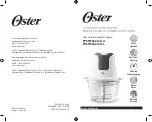
There are several ways to reduce “wrap around.” At the high gains used with low en-
ergy sources, there are two contributors to the effect. The first is the pulse height itself;
the second is the elevated baseline due to amplified detector noise. If the effect is trou-
blesome, try using a higher energy source and lowering the gain when optimizing the
pole/zero. Lowering the gain will reduce both pulse height and noise to eliminate
“wrap around,” while maintaining good signal/noise conditions for adjusting the pole
zero. When completed, return the 9660 gain to the setting required for the intended ap-
plication. If a high energy source is not available, the “wrap around” can still be de-
creased by simply lowering the gain or rise time setting. This will lower the digital
filter’s gain and sensitivity to offset and reduce the wrap around effect. Although this
also lowers the pole/zero error sensitivity or magnitude, it can be compensated for by
increasing the sensitivity of the oscilloscope. When done optimizing the Pole/Zero, re-
turn the gain or rise time back to the setting required for the intended application.
For further discussion of the “wrap around,” effect, please refer to “Trapezoid Output”
on page 29.
Baseline Restorer
The digital baseline restorer in the Model 9660 is flexible and allows adjustment for
varying baseline conditions affected by detector type, noise and count rate. The base-
line restorer rate is selected using the BLR mode drop down menu in the Filter Device
Adjust screen.
With the Baseline set to AUTO, the digital baseline restorer is automatically set for
optimum performance throughout the usable input count rate range.
The restorer can also be set to three manual settings: SOFT MEDIUM and HARD.
These setting can be used with detectors having exceptionally stable baselines at all
rates, or with detectors which at high rates develop unusual noise, requiring a some-
what lower restoration rate than provided by AUTO Rate. The SOFT selection signifi-
cantly reduces the baseline restorer’s restoration rate. This may prove to be
advantageous in some low count rate/low energy applications. With the SOFT se-
lected, the restorer’s low frequency noise suppression effectiveness is reduced. The
ambient low frequency noise and the implementation of noise reduction techniques re-
garding setup can easily be assessed and tested.
For situations where a higher than normal restoration rate is required, the restorer rate
may be set to MEDIUM or HARD, which increases restoration rate proportionately.
This can improve performance at extremely high input counting rates or where more
control is required to maintain the baseline, such as with some NaI(Tl) scintillation de-
tector systems.
User’s Manual - ICN 9231014G
71
Baseline Restorer













































